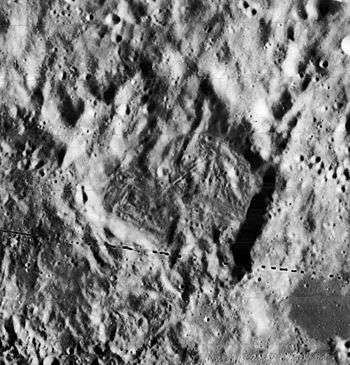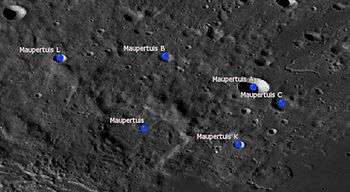Maupertuis (crater)
 Lunar Orbiter 4 image | |
| Coordinates | 49°36′N 27°18′W / 49.6°N 27.3°WCoordinates: 49°36′N 27°18′W / 49.6°N 27.3°W |
|---|---|
| Diameter | 45.49 km |
| Depth | 1.5 km |
| Colongitude | 28° at sunrise |
| Eponym | Pierre Louis Maupertuis |
Maupertuis is the remnant of a lunar impact crater that is located in the northern part of the Moon's near side. It lies in the stretch of rugged terrain north of Sinus Iridum, a bay in the northwestern corner of Mare Imbrium. To the north lies the crater La Condamine, and Mare Frigoris and to the northwest is Bianchini.
This is a crater that has been nearly obliterated by a history of impacts, leaving only a disintegrated remnant of the original rim. The surviving outer rim is not especially circular, having been reshaped into a somewhat pentagonal outline. There are deep gouges from cratering along the northeastern rim. The interior floor is not in much better shape, being rough and irregular.
To the northeast of this crater is a system of rilles designated Rimae Maupertuis.[1] These are considered to have formed through geological activity. Good eyesight and a large telescope are required to observe these rilles.
The crater was named for the French mathematician and astronomer Pierre Louis Maupertuis (1698–1759).[2]
Satellite craters

| Maupertuis | Latitude | Longitude | Diameter | Ref |
|---|---|---|---|---|
| A | 50.6° N | 24.7° W | 13.91 km | WGPSN |
| B | 51.3° N | 26.7° W | 6.07 km | WGPSN |
| C | 50.2° N | 24.0° W | 10.47 km | WGPSN |
| K | 49.3° N | 25.0° W | 5.28 km | WGPSN |
| L | 51.3° N | 29.2° W | 6.21 km | WGPSN |
See also
- Asteroid 3281 Maupertuis
References
- ↑ "Rimae Maupertuis". Gazetteer of Planetary Nomenclature. USGS Astrogeology Research Program.
- ↑ Schmadel, Lutz D.; International Astronomical Union (2003). Dictionary of minor planet names. Berlin; New York: Springer-Verlag. p. 273. ISBN 978-3-540-00238-3. Retrieved 9 September 2011.
Further reading
- Andersson, L. E.; Whitaker, E. A. (1982). NASA Catalogue of Lunar Nomenclature. NASA RP-1097.
- Blue, Jennifer (July 25, 2007). "Gazetteer of Planetary Nomenclature". USGS. Retrieved 2007-08-05.
- Bussey, B.; Spudis, P. (2004). The Clementine Atlas of the Moon. New York: Cambridge University Press. ISBN 978-0-521-81528-4.
- Cocks, Elijah E.; Cocks, Josiah C. (1995). Who's Who on the Moon: A Biographical Dictionary of Lunar Nomenclature. Tudor Publishers. ISBN 978-0-936389-27-1.
- McDowell, Jonathan (July 15, 2007). "Lunar Nomenclature". Jonathan's Space Report. Retrieved 2007-10-24.
- Menzel, D. H.; Minnaert, M.; Levin, B.; Dollfus, A.; Bell, B. (1971). "Report on Lunar Nomenclature by the Working Group of Commission 17 of the IAU". Space Science Reviews. 12 (2): 136–186. Bibcode:1971SSRv...12..136M. doi:10.1007/BF00171763.
- Moore, Patrick (2001). On the Moon. Sterling Publishing Co. ISBN 978-0-304-35469-6.
- Price, Fred W. (1988). The Moon Observer's Handbook. Cambridge University Press. ISBN 978-0-521-33500-3.
- Rükl, Antonín (1990). Atlas of the Moon. Kalmbach Books. ISBN 978-0-913135-17-4.
- Webb, Rev. T. W. (1962). Celestial Objects for Common Telescopes (6th revised ed.). Dover. ISBN 978-0-486-20917-3.
- Whitaker, Ewen A. (1999). Mapping and Naming the Moon. Cambridge University Press. ISBN 978-0-521-62248-6.
- Wlasuk, Peter T. (2000). Observing the Moon. Springer. ISBN 978-1-85233-193-1.
External links
| Wikimedia Commons has media related to Maupertuis (crater). |
- "Maupertuis". Gazeteer of Planetary Nomenclature. International Astronomical Union. Retrieved 12 September 2017.